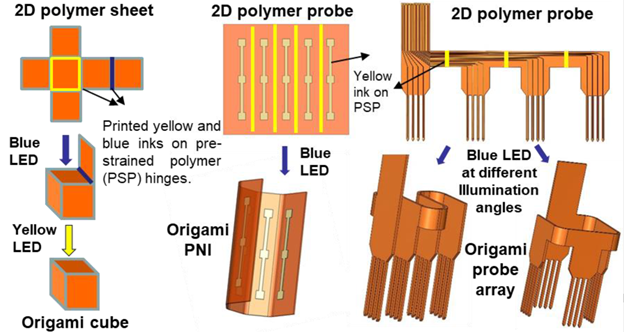The design, development, and manufacturing of flexible, high-resolution 3D microstructures will expand the application space across multiple areas of research, such as high-density and high-resolution 3D versions of cuff electrodes for peripheral nerve stimulation, optogenetic probes, energy storage devices, multiscale chemical reactors, and devices for in vivo studies. This invention allows for the formation of 3D structures from existing 2D sheets.
The approach involves 3D printing hinges made of Pre-Stressed Polymers (“PSP”) onto polyimide (“PI”) substrates. These hinges are then able to fold in response to externally applied stimuli, such as light. First, 2D PI devices will be microfabricated. Then, PSP infused with colored inks will be printed using Direct Ink Write (“DIW”) on the hinges of the PI devices. When exposed to light with specified wavelength, the colored inks will absorb the light, heat the PSP, which will then fold themselves and the PI sheet underneath.
- Applicable to materials that are lithographically patternable, biocompatible, flexible, low-cost, and lightweight -> low operational and material costs
- Applicable to microstructures that need printable patterns inside inner cavities
- Benefits high-channel density implants, 3D chemical reactors, foldable microfluidic cell-culture arrays, reconfigurable electronics, actuators, & sensors, and deployable systems in defense and space.
- Flexible MEMS applications: reconfigurable electronics, actuators, and sensors
- High-density medical implants
- 3D chemical reactors
- Foldable microfluidic cell culture arrays
Current stage of technology development: TRL 2
LLNL has filed for patent protection on this invention.
U.S. Patent No. 11,691,378 Bend inducible Self-Folding Origami Flexures and Microsystems issued 07/04/23


